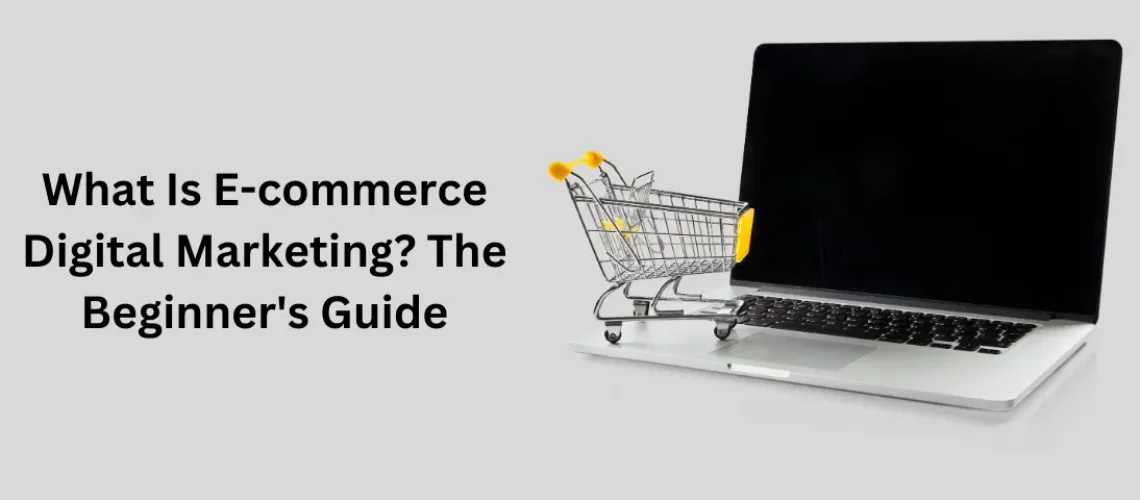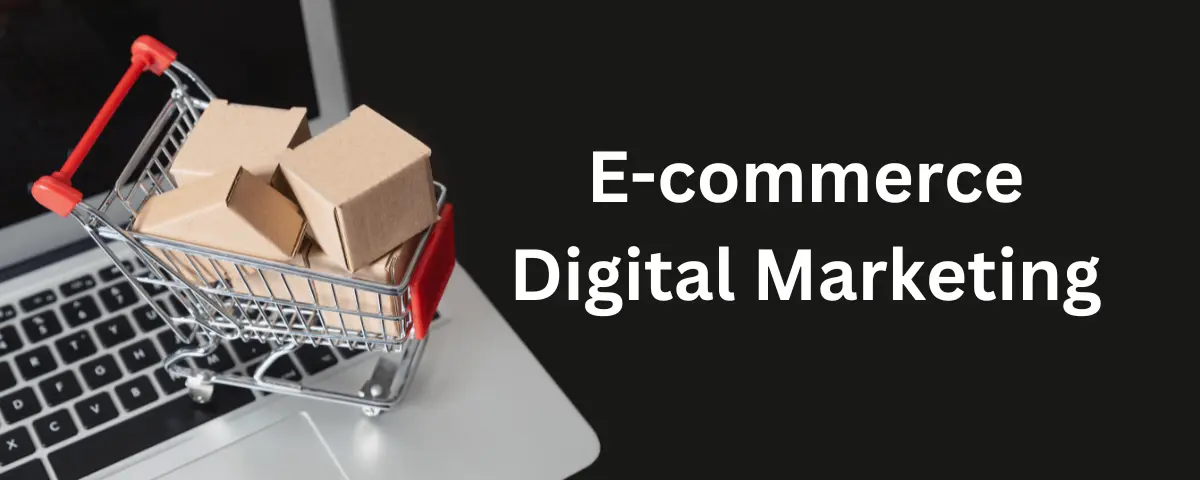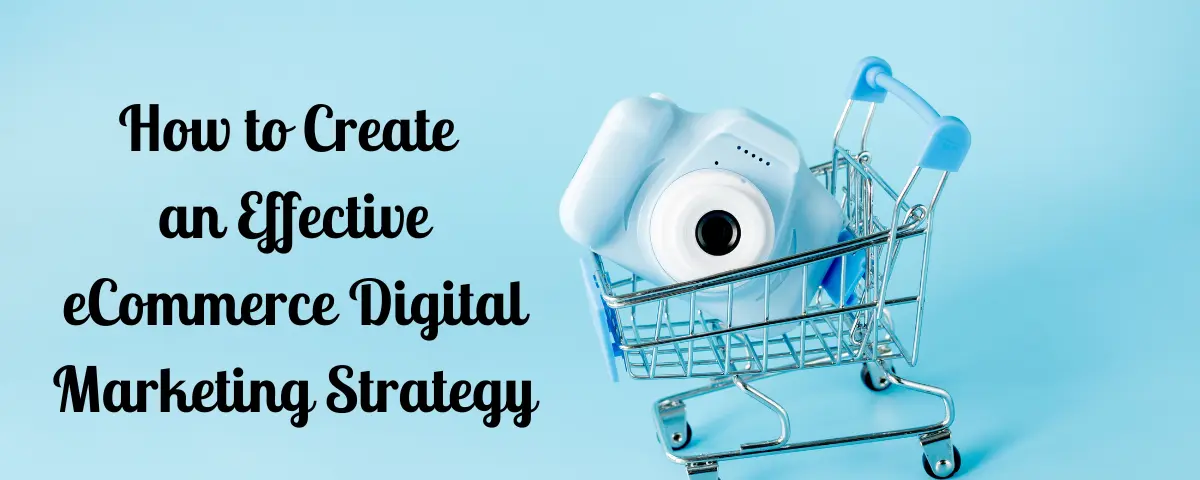In the expansive world of online shopping, e-commerce has changed how we shop and do business. But with so many online stores out there, how can retailers get noticed? That’s where e-commerce digital marketing plays a key role.
e-commerce digital marketing involves promoting and selling products or services online through digital channels like search engines, social media, email, and websites.
If you want to connect with millions of potential customers with just a few clicks, then e-commerce digital marketing is the strategy to employ for your e-commerce business.
To understand the basics of e-commerce digital marketing, you can take our digital marketing course to learn how you can help businesses attract customers, bring traffic to their websites, and boost sales.
In this article, we will take you by the hand and walk you through the fundamentals of e-commerce digital marketing, covering everything from the basics to advanced strategies for success.
So let’s get started
What is E-commerce Digital Marketing?
E-commerce, or electronic commerce, is the buying and selling of goods and services online. It involves transactions conducted on digital platforms such as websites, mobile apps, and social media. E-commerce has revolutionized business by enabling companies to reach a global market, boost sales, and improve customer satisfaction.
E-commerce digital marketing, on the other hand, involves promoting online stores, products, and services through digital channels using technology and data to increase sales, revenue, and customer interaction. It’s a great time to be in e-commerce, as the market shows no signs of slowing down. By 2027, experts predict it’ll total over $7.9 trillion.
It includes different strategies, methods, and techniques to:
- Get people to visit the online store
- Get people to buy things
- Keep customers coming back
Get 50% Discount to Master ALL Aspects of Digital Marketing That Can Earn You $2,500 - $5,000 a month (Even if you are a complete beginner!)
Our students that intentionally implement what they learn from our digital marketing course make back the entire course fee within a single month or more after completing our course because our course gives them many income generating options with unlimited earning potential with no age or location barrier. The best part is no technical skills are required.
An opportunity to change your lifestyle and make money working from anywhere in the world. The results our students get from our digital marketing course prove this could be applied to any market or country and that it is designed for any skill level and work background.
*By signing up, you agree to our privacy policy and terms of service.
The primary goal of digital marketing in ecommerce is to attract and interact with potential customers on the platforms where they spend the most time online, such as social media, search engines, email, and websites. When you use these channels properly, businesses can make their brand more visible, attract more visitors to their online store, find potential customers, and increase sales.
Achieving success in digital marketing for e-commerce requires a deep understanding of customer behaviour, market trends, and innovative technologies. When you leverage data and analysis, businesses can create personalized experiences that resonate with their target audience, build brand loyalty, and drive long-term growth.
Why E-Commerce Marketing Is Important
E-commerce marketing is vital for the success of online businesses. As consumers increasingly turn to digital platforms for their shopping needs, companies must establish a strong online presence.
Through the implementation of e-commerce marketing strategies, online store owners can boost sales, and enhance brand recognition and reach.
Some of the importance of E-commerce marketing include:
- Increased online sales: The primary goal of e-commerce is to boost sales. With online shopping, customers can make purchases anytime, leading to more transactions for your business.
- Brand awareness: E-commerce marketing helps businesses increase their brand’s visibility and recognition among potential customers, making them more memorable and preferred.
- Global reach: E-commerce allows businesses to sell products and services to customers all over the world, breaking geographical barriers and expanding their market.
- Cost-effective: Digital marketing strategies, such as social media and search engine optimization, can be more affordable and effective than traditional advertising methods, allowing businesses to reach a larger audience.
- Competitive advantage: With more businesses moving online, effective e-commerce marketing helps companies stand out in a crowded marketplace, attracting more customers and retaining existing ones.
- Improved customer experience: When you leverage data and technology for your e-commerce marketing, it can help you create a more personalized, seamless, and enjoyable shopping experience for customers, leading to higher satisfaction and loyalty.
- Customer Insights: E-commerce platforms collect valuable data about customer behavior, preferences, and shopping habits. This information helps businesses tailor their marketing strategies and improve customer experience.
- 24/7 Availability: Online stores are open all day, every day, making it convenient for customers to shop whenever they want. This constant availability can lead to higher sales.
Finally, e-commerce marketing is very important for businesses that want to succeed in today’s online world.
Types of E-Commerce Digital Marketing
There are various channels that can help your e-commerce business reach and engage with your target audience, drive website traffic, and increase sales and revenue.
Types of e-commerce digital marketing channels include:
1. Search Engine Optimization (SEO)
This involves optimizing your website, content and product pages to rank higher in search engine results pages (SERPs), making it easier for customers to find you. his help you to drive more organic traffic to your e-commerce site and could lead to more sales.
2. Pay-Per-Click (PPC) Advertising
Platforms like Google Ads and Bing Ads allow you to display ads in search results and on other websites. You only pay when someone clicks on your ad and this could drive immediate traffic to your website.
3. Social Media Marketing
You can use social platforms like Facebook, Instagram, Twitter, and Pinterest to engage with customers. This can help you build brand awareness for your products and drive more sales to the business.
4. Email Marketing
This channel uses emails to communicate with customers or subscribers. Businesses can send newsletters, promote products, and personalized messages to keep customers informed and engaged. This can also help nurture customer relationships.
5. Content Marketing
Content marketing involves creating valuable content, such as blog posts, videos, and infographics, to attract and retain potential customers and provide them with useful information related to your products. An example of a brand that does this perfectly is Jumia.
6. Influencer Marketing
This strategy involves partnering with influencers who promote products to their followers. You can leverage the influencer’s credibility to reach a wider audience.
7. Affiliate Marketing
In affiliate marketing, businesses reward affiliates (partners) for driving traffic or sales to their websites through their marketing efforts. This is another opportunity for businesses to get more sales when people refer to their products.
8. Video Marketing
This involves using platforms like YouTube or TikTok to create engaging video content about your products. Videos allow brands to demonstrate how products work, showcasing their features and benefits effectively. E-commerce brands that use video marketing experience up to 49% faster revenue growth compared to those that don’t.
9. Mobile Marketing
This involves optimizing the e-commerce experience and strategies aimed at reaching customers on their mobile devices through apps, SMS, and mobile ads.
10. Analytics and Optimization
These are crucial components of e-commerce marketing, particularly when it comes to improving the effectiveness of advertising campaigns. It involves leveraging data, businesses can analyze their marketing efforts and make informed decisions to enhance performance.
Others include:
- Referral Marketing
- Chatbot Marketing
- Podcast Marketing
- Native Advertising
Each of these channels has unique strengths and can be combined to create an effective e-commerce marketing strategy that reaches a diverse audience and drives sales.
How to Create an Effective eCommerce Digital Marketing Strategy
It is crucial to develop a strong digital marketing strategy to achieve success with your e-commerce business.
# 1. Define your goals and target audience
In developing your ecommerce strategy, you are specifically targeting tech-savvy individuals aged between 25 and 45 who are comfortable with online shopping. Your target audience prioritizes convenience, quality products, and exceptional customer service.
So your marketing strategies should start by clearly outlining what you want to achieve and who you’re trying to reach.
- Are you aiming to increase overall sales?
- Did you want to boost brand awareness?
- Launch a new product line?
When you understand your objectives and ideal customer, this will shape your entire strategy. It is also important for you to establish specific, and measurable objectives for your eCommerce business.
#2. Develop a Unique Value Proposition
Clearly define your brand’s unique selling points and benefits. You should create a distinctive value proposition that distinguishes you from your competitors.
Start by analysing what your competitors are doing well and where they may be lacking. Look into their digital marketing strategies, including social media presence, email campaigns, and SEO tactics. This research will help you identify market gaps and differentiate your brand from competitors
This is a great opportunity for you to do better in the areas your competitors might be lacking and you should also provide top-quality services, and ensure a smooth online shopping experience for your loyal customer base.
#3. Choose Digital Marketing Channels
When creating an ecommerce marketing strategy, it is crucial to select the digital marketing channels that will effectively reach your target audience.
Among the listed marketing channels listed above, select the most effective channels that you want to use to promote your business, drive traffic to your online store and boost sales.
Start by understanding where your target audience spends their time. Are they on social media, browsing blogs, or checking emails? Focus on a few key channels that align with your goals. For example, you can use social media for engagement and brand awareness, while email marketing can drive sales through personalized offers.
Another thing you can do is to analyze your competitors to see what works for them. You can also test all these different approaches, monitor the results, and adjust your strategy as needed.
The best marketing channels are the ones that will help you connect with customers effectively.
# 4 Optimize your website
Ensure that your website is mobile friendly user-friendly,(mobile-responsive, and secure online shopping experience) because mobile users make up the bulk of online shoppers. As of the first quarter of 2024, smartphones accounted for approximately 77 percent of global retail website traffic and were responsible for generating two-thirds of online shopping orders.
So make sure to optimize your product pages and product recommendations for search engines when people search with keywords that are relevant to your products. This includes using descriptive titles, engaging product descriptions, and relevant tags that match the search intent of potential customers.
I also want you to remember that your website is often the first impression customers have of your brand. So make sure your website loads faster, easy to navigate, and includes clear calls-to-action at every necessary point.
#5. Create engaging content
Creating engaging content is essential for attracting and retaining customers in eCommerce. Start by understanding what your audience cares about—this could be product tips, how-to guides, or industry insights.
Use a mix of formats, like blog posts, videos, and infographics, to keep things interesting and make sure your content is visually appealing and easy to read.
When you create content, create high-quality, informative content that resonates with your customers and encourages interaction by asking questions or inviting comments.
This will keep customers close to your brand, establish your e-commerce business as an authority in your niche and keep customers coming back for more.
Finally, don’t forget to also share your content on social media to reach a wider audience.
#6. Leverage Email Marketing and Automation
Email marketing is a powerful tool for eCommerce businesses, allowing you to connect directly with your customers. Start by building a segmented email list, which helps you send targeted messages based on customer preferences and behaviors. For instance, you can create separate lists for new subscribers, loyal customers, and those who have abandoned their carts.
You can use automation to streamline your campaigns. For instance, set up welcome emails for new subscribers, follow-up emails after purchases, and reminders for abandoned carts. Automation saves you time and ensures that your messages reach customers at the right moment.
You can also make your emails engaging by including personalized product recommendations, special offers, and valuable content. This will help you to nurture relationships, boost sales, and keep your brand top-of-mind.
#7. Invest in Paid Advertising
Investing in paid advertising is smart for eCommerce businesses looking to boost visibility and drive sales. You should start by identifying your target audience and choosing the right platforms, such as Google Ads, Facebook, or Instagram, where your customers are most active.
Paid ads allow you to reach potential customers quickly and reach more audiences at once. You have to be creative by using eye-catching visuals and compelling copy to grab attention. There are different ad formats you can experiment with, like carousel ads for showcasing multiple products or video ads for storytelling.
To get started, set a budget that works for you, run and monitor your campaigns closely. By paying attention to metrics that matter to your campaign like click-through rates and conversions to see what’s effective. Don’t hesitate to adjust your strategy based on performance data.
#8. Implement Cart Abandonment Strategies
E-commerce business owners must implement cart abandonment strategies to boost conversions and maximize sales.
You can do this by analyzing customer behavior and pinpointing common reasons for abandoned carts, then develop targeted campaigns to re-engage customers and motivate them to finalize their purchases.
You can use tactics such as personalized emails, retargeting ads, and providing incentives to aid in recovering lost sales and enhancing overall revenue. It is crucial to use these strategies to ensure continued success.
#10. Measure Your Results
To measure your results, start by tracking your performance to see what’s working and what needs improvement.
Start by defining key performance indicators (KPIs) that align with your goals, such as website traffic, conversion rates, and return on ad spend (ROAS). This will help you to monitor the right metrics to get the right result
Use tools like Google Analytics, social media insights, and email marketing reports to gather data. For example, if you notice a high click-through rate but low conversions, it may indicate a need to improve your landing page.
When you continuously measure and optimize your efforts, you’ll be better positioned to achieve your eCommerce goals and grow your business.
3 eCommerce Digital Marketing Examples
Some Nigerian brands and businesses have successfully used eCommerce digital marketing strategies to reach and engage with their target audience. You can use them as examples to create your strategy.
#1. Jumia’s Affiliate Marketing Program
Jumia offers a diverse selection of products such as electronics, fashion, beauty, home essentials, so the brand provides numerous chances for affiliates to earn commissions on sales they refer.
This is done on a pay-per-sale program. The affiliate only gets paid when the people he or she refers to make a complete purchase. The good thing is that, unlike many other programs, Jumia adopts the 30-day cookie method. This means, that if a customer clicks on an affiliate’s link and buys a product from Jumia within the next 30 days, the affiliate will still get his commission irrespective of what they buy.
All it requires to make money from Jumia affiliate marketing is to generate quality leads that will convert to sales. Jumia has competitive commission rates, an easy-to-use affiliate dashboard, and a range of promotional materials to make earning easy for affiliates.
#2. Flutterwave’s Influencer Partnerships
In today’s digital age, where online transactions are essential for global trade, Flutterwave, Africa’s top payments technology company, and partnered with Nigeria’s Economic and Financial Crimes Commission (EFCC) in a significant step forward in the continent’s battle against cybercrime. The collaboration between Flutterwave and EFCC represents a significant fusion of private sector innovation and public authority, leveraging technological prowess and legal expertise to drive positive change in Africa.
The African fintech company made a series of strategic partnerships;
Token.io Partnership: Flutterwave has teamed up with Token.io, a payment infrastructure provider. This collaboration allows Flutterwave’s merchants to reach customers in the U.K. and Europe.
Audiomack Partnership: The company has also partnered with Audiomack, a popular U.S. music-streaming platform. Through this partnership, Flutterwave aims to offer more services to its customers.
Microsoft Agreement: Flutterwave entered into a five-year agreement with Microsoft. The goal is to facilitate transactions on Azure across Africa, which opens doors for business growth and expansion
#3. Andela’s Referral Program
Andela’s referral program incentivizes developers to refer friends and colleagues to the platform. Andela offers a referral program for employees to recommend candidates for available positions within the organization. If the referred candidate is successfully hired and remains with the company for a specified duration, the referrer may be eligible to receive a referral bonus.
Employees benefit from Andela’s referral program in several ways; financial Incentives, strengthening team culture, networking, opportunities, career growth, job satisfaction and recognition.
Tips for a Successful eCommerce Digital Marketing Strategy
Below are some of the tips you can use to create a comprehensive E-commerce digital marketing strategy that drives sales, revenue, and long-term growth:
1. Know your customer inside out
To get started, dive deep into customer data and create detailed buyer personas. This will help you to understand your audience’s needs, preferences, and pain points as it is crucial for tailoring your marketing efforts effectively.
2. Create a seamless omnichannel experience
Ensure your brand message and customer experience are consistent across all platforms from your website to social media to email campaigns. This helps build trust and makes shopping more convenient for your customers.
3. Leverage user-generated content
Encourage customers to share photos, videos, and reviews of products that were purchased. This authentic content can be incredibly persuasive to potential buyers and great for social proof.
4. Personalize, personalize, personalize
Use data to offer personalized product recommendations, email content, and special offers. Customers are more likely to engage with content that feels tailored to them.
5. Optimize for mobile
With more people shopping on their phones, ensure your site is mobile-friendly and consider developing a mobile app for an even smoother experience.
6. Implement chatbots
You can use AI-powered chatbots to provide instant customer service, like answering FAQs, and even guide purchasing decisions when customers are trying to make a purchase.
Remember, the key to a successful eCommerce digital marketing strategy is to stay customer-focused, data-driven, and adaptable. Keep testing new ideas, stay on top of emerging trends, and always be ready to pivot based on what the data tells you.
How is Digital Marketing for eCommerce Different?
Digital marketing for eCommerce is different from traditional digital marketing in several ways. Therefore, it is important to recognize the differences so you can tailor your digital marketing strategies to effectively drive sales, revenue, and growth in the eCommerce space.
Some of the differences include:
- Focus on Sales: eCommerce marketing is all about making sales. Every strategy, whether it’s ads or emails, aims to turn visitors into customers.
- Product-Driven Content: The content in eCommerce is usually centered around products. This means using detailed descriptions, attractive images, and customer reviews to showcase items, rather than just telling a brand story.
- Specific Channels: eCommerce marketing uses certain channels like paid ads, social media ads, and email marketing specifically to drive sales. While these channels are used in general digital marketing, eCommerce focuses on them for immediate purchases.
- Customer Journey: eCommerce marketing pays special attention to the customer journey. This means making it easy for customers to go from discovering a product to buying it. For example, showing ads to people who looked at items but didn’t buy them.
- Tracking Results: In eCommerce, it’s crucial to track specific numbers like conversion rates and how many people leave items in their carts. These metrics help businesses understand how well they are selling.
- Personalization and Automation: eCommerce often uses personalized messages and automated emails to improve the shopping experience. For example, sending recommendations based on what a customer looked at or bought before.
In short, eCommerce digital marketing is focused on driving sales and making the shopping experience as smooth as possible for customers.
Conclusion
e-commerce digital marketing is vital for any online business looking to succeed. It includes various strategies like SEO, social media marketing, email campaigns, and content creation, all designed to attract and keep customers. When you understand your audience and use the right channels, you can effectively promote your products and engage with shoppers.
It’s also important to regularly check how your marketing efforts are performing and make adjustments as needed. This way, you can stay up-to-date with trends and what customers want.
To gain in-depth training on the marketing strategy that will set your e-commerce business up for long-term growth and customer loyalty in the competitive online marketplace, you can sign up for our digital marketing training today.
FAQ
What is digital marketing in e-commerce?
Digital marketing in e-commerce involves using different online platforms and techniques to market and sell products or services on the Internet. This can include strategies like SEO, social media marketing, email marketing, content marketing, PPC advertising, and collaborating with influencers. The main objective of digital marketing in e-commerce is to draw in, interact with, and convert potential customers through focused and trackable online initiatives.
Which platform is best for ecommerce marketing?
The optimal e-commerce marketing platform is determined by a range of factors, including the type of business, target audience, and marketing goals. Popular e-commerce marketing platforms include Shopify, WooCommerce, Magento, BigCommerce, and Squarespace.
Shopify is renowned for its user-friendly interface and wide range of apps, making it suitable for businesses of all scales. WooCommerce, a WordPress plugin, provides flexibility and customization options for businesses already utilizing the platform. However, in the realm of e-commerce marketing, the optimal platform is one that is tailored to fit the unique requirements, financial constraints, and future objectives of your business.
More Posts
What is Ecommerce? Everything to Know Before Starting an Ecommerce Business
Digital Marketing vs Traditional Marketing in 2024: Which is Better?
How to Build a Succesful Career in Digital Marketing in 2024 (+ 5 Experts Advise)
How to Use B2B Social Media Marketing Strategy to Attract New Customers








